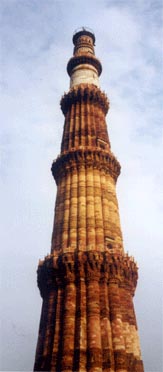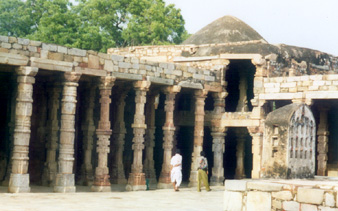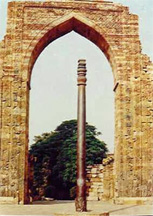Apr 14, 2025
Apr 14, 2025
by Chandrika
 Besides visiting Jaipur, I also visited Qutab Minar during my recent visit to India.
Besides visiting Jaipur, I also visited Qutab Minar during my recent visit to India.
The foundation for the Qutab Minar and the monuments adjacent to it was laid by Qutb-al-din-Aibak, the Turk commander who ascended to the throne of Delhi in 1206. The complex was built on the remains of Lal Kot, an older Hindu city, 15km south of Delhi. In this way an older civilization literally provided the material for the new one. But notwithstanding the indigenous Indian workmanship, the Qutab Minar is, in fact, the last and the grandest of the Ghaznavid and Seljuqid funerary towers built in Afghanistan and Iran.
Qutb-ud-din-Aibak had intended the Qutab Minar to stand as a symbol of his throne's might. However, he passed away before anything more than the base of the tower could be completed. It was his successor, Iltutmish, who completed this magnificent structure. The red sandstone tower of Qutab Minar is 72.5 m high, tapering from 14.32 m at its base to 2.75 m in diameter at its peak, and alternating in angular and rounded flutings. Much as its dimensions contribute to its magnificence, one can't deny that the intricate carving, taken from the Islamic Holy Book - the Qu'ran, on the exterior also makes it look breathtakingly beautiful.
 Next to the Qutab Minar is the Quwwatu'l - Islam Masjid. Built on a number of pillars this complex is a reminder of the old Indian architecture which is repetition of motifs.
Next to the Qutab Minar is the Quwwatu'l - Islam Masjid. Built on a number of pillars this complex is a reminder of the old Indian architecture which is repetition of motifs.
It is said that the pillars used in this mosque were taken from the 27 temples of Qila Rai Pithora, the city of the Rajput king Prithviraj chauhan.
The Iron Pillar

In the courtyard of the Quwwatu'l-Islam mosque stands the famous iron pillar, which bears a Sanskrit inscription in Gupta script, assignable to the 4th century. The inscription records that the pillar was set up as a standard or dhvaja of god Vishnu on the hill known as 'Vishnupada', in the memory of a mighty king, named 'Chandra', who is now regarded as identical with Chandragupta II (375-413) of the imperial Gupta dynasty. The base of the pillar is knobby, with small pieces of iron tying it to its foundations, and a lead sheet covers the portion concealed below the present floor-level.
According to the British historian Percival Spear, there was a statue attached to the pillar but he failed to identify it. Dr Munish Chandra, former additional director-general of ASI and noted scholar claims that the attached statue was that of Vishnu which the Muslim invaders destroyed.
The total length of this slightly tapering shaft is 23 feet 8 inches in length and its diameter varies from 12.5 inches at the top to 16.4 inches on the ground. The metal of the pillar has been found to be almost pure malleable iron. Its portion below the ground shows some signs of rusting, but at a very slow rate. The manufacture of such a massive iron pillar, which has not deteriorated much during seventeen hundred years of its existence, is a standing testimony to the metallurgical skill of ancient Indians.
A traditional belief says that the mighty Bheem (the mythological strongman of the Mahabharata) lifted the pillar with his right hand and impaled it in the ground. With this myth is also attached a legend that any one who can encircle the entire column will have their wish granted. However, it is fenced off from tourists so as to avoid any damage.
07-Oct-2001
More by : Chandrika